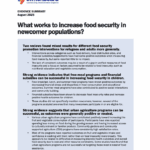Food insecurity and housing instability are pervasive issues in the United States and disproportionally affect immigrants and have many negative consequences for low-income families. Although evidence shows that food insecurity contributes to housing instability, how it affects immigrants, the duration of food insecurity, and the role of the neighborhood context in this relationship remain largely unknown. Using longitudinal data from the Fragile Families and Child Wellbeing Study, we find that the negative association of food insecurity is 3 times larger for immigrants than for nonimmigrants. In addition, persistently food insecure families have the highest risk of experiencing housing instability compared to families experiencing short-term food insecurity. The findings point to potential positive externality effects of anti-hunger and food assistance programs on reducing material hardships beyond food insecurity and the particular policy implications for immigrants.
The management of volunteers – What can human resources do? A review and research agenda
There is an increasing interest from scholars and practitioners in understanding how non-profit organizations can design and implement human resources (HR) practices to enhance desirable volunteer attitudes and behaviors. This paper presents a comprehensive overview of existing studies on the relationship between HR practices and volunteering outcomes. We use the ability-motivation-opportunity model as a guiding…

